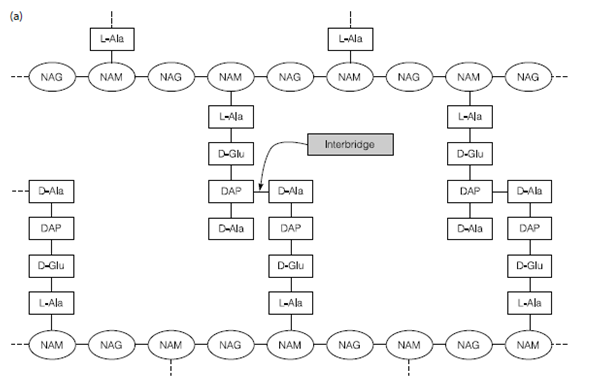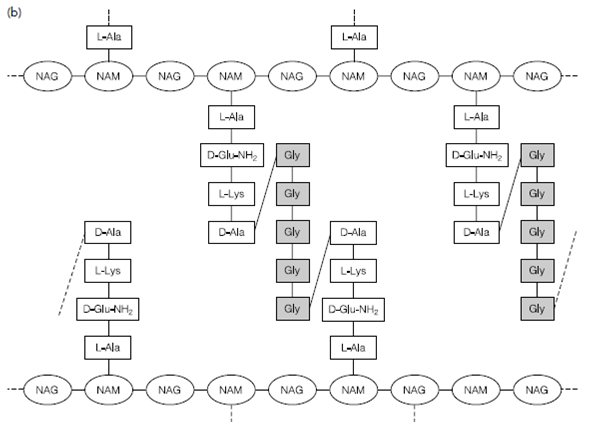Peptidoglycan
Peptidoglycan or murein is made up of two sugar derivatives N-acetylglucosamine and N-acetylmuramic acid with a b1–4 linkage. Chains of alternating NAG and NAM are cross-linked through amino acids such as d-glutamic and l-alanine acid as well as diaminopimelic acid. The way in which the cross links are formed differs in Gram-positive and Gram- negative Bacteria in Figure 2. In most Gram-negative Bacteria there is a direct interbridge among polypeptide side-chains emerging from adjacent NAG or NAM polymers although in most Gram-positive Bacteria the interbridge in which links side-chains is a glycine pentapeptide. The structure of peptidoglycan is highly conserved among the Bacteria as a whole the only variations being slight changes in the interbridge. Peptido- glycan is resistant to many chemical challenges, but is easily broken down through lysozyme that breaks the bonds between NAG and NAM. Without the constraining polymer the osmotic potential is too much for the cell membrane to contain and the cell bursts. Lysozyme is present in several human bodily secretions as the first form of defense against Bacterial invasion. Those cells without peptidoglycan avoid this lysis.
The Gram-positive Bacteria have substances called teichuronic and teichoic acids inter- spersed with the peptidoglycan polymer. ‘Teichoic’ is a wide term covering polymers containing glycerophosphate or ribitol phosphate and the primary function of these


Figure 2. Structure of peptidoglycan from (a) Escherichia coli and (b) Staphylococcus
aureus. NAG, N-acetylglucosamine; NAM, N-acetylmuramic acid; DAP, diaminopimelic acid. The remainder of the abbreviations refers to the d or 1 forms of the amino acids listed in Section E1.
compounds appears to be to bind essential divalent cations like as Mg2+, maintaining the local ionic environment of the cell. The gross effect of the presence of teichoic acids in the membrane is to provide the cell a slightly negative charge.
It is extremely hard to generalize on Archaeal cell wall structure as the diversity is far higher than which of the Bacteria. While our knowledge of the Archaeal cell wall is not as highly build as that of Bacteria we do know that some Archaea have a compound very same to the murein named pseudopeptidoglycan. This has a backbone containing NAG, but alternating NAM is replaced with N-acetyltalosaminuronic acid and is b1–3 linked instead of b1–4. However several Archaea maintain rigidity with the use of a mixture of polysaccharide, protein and glycoprotein.